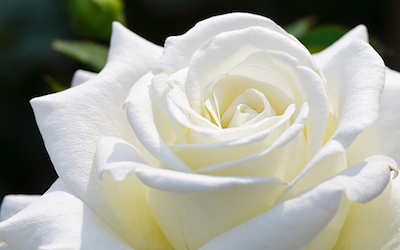In death and dying there is life. We must die to be reborn… These are hackneyed old religious precepts that come round and round. They are clearly metaphors for some kind of transition process.
In fact, during my own extensively researched science of mind and consciousness I call Supernoetics®, there is every indication that, at the extremes of consciousness (dying and having vivid transpersonal experiences), people do surrender “selfhood” and cease to be as a separate entity, while clearly finding renewed Being and meaning as part of a greater whole that some may term God.

I first began learning about death and dying as an event right back early in medical school. One bright and beautiful April morning, when the sun was shining and I felt the song of my youth as I walked to class at the hospital, I suddenly found myself a part of a death transition. A young girl, 6 years of age, was brought into Casualty (ER to those of you who use that term), her head smashed. No, not a horrific car accident: something far more troubling. She had been visiting a museum with her Mom and Dad and had somehow managed to pull over a giant cabinet full of coins on top of herself.
The heavy piece weighing upwards of 1,000 lbs. had crushed her. She was unconscious and bleeding from the ear and nose—a very bad sign.
I was just a green medical student. I looked on in horror, helping as best I could, while the duty doctor fought savagely to save her. It was to no avail. Massive intracranial bleeding sealed her fate and she was soon pronounced dead.
They gave me the job of breaking the news to the parents. This is a difficult part of a physician’s job and it was right to get me facing up to these duties as soon as possible in my education. I got through it.
Then I went back to look at the corpse, still warm, while the casualty officer did his paper work. I tried to imagine this child at play only a few hours before the fateful outing. Somehow it would have made more sense for her to have been knocked down by a drunk driver than pulling a piece of furniture over on top of herself.
As I stood there, quite bemused, I saw the first indication of the life of spirit. A wonderful vaporous mist began to draw up from the girl’s body and hover just above her. It was just a few feet across; unmistakable. It lingered there and I felt myself wanting to exchange farewells.
In a daze myself, I was not really trying to interpret what was happening. I just watched in awe. Everything I have ever believed since about life and death, God and spirit, came to me in those precious moment—and the certainty of life eternal has never left me.
I do not subscribe to scriptural drivel, as many of you know. The sanitized and edited “truths” peddled by the priest classes have no place in real enquiry and a deeper knowledge of life and meaning. I got my learning that morning, not from a “holy” book, but from a little girl, struggling to figure out what had just happened.
It was a quiet, personal moment, just between her and me (or should I say “it” and me by this stage?) It lasted several minutes and then gradually transitioned into a more normal reality. The orderlies eventually arrived and put her body onto a gurney and marched it off.
But that little child is with me still and probably always will be. If ever I have studied and practiced the sacred arts of healing, it has been to honor her and what I saw that day. I am so grateful.
Modern Research and Change of Viewpoint
Our view of death and dying is beginning to change slowly. The recent passing of my Mum as a gentle and peaceful ritual I have already shared, with you my readers. There was loss, yes, sadness, yes, but not pain.
Today we are realizing more and more that the time of death may be much more positive than traditionally assumed. Indeed, I am emboldened enough to say the problem is with the living—those left behind—not the dead and dying.
[clickToTweet tweet=”Today we are realizing more and more that the time of death may be much more positive than traditionally assumed.” quote=”Today we are realizing more and more that the time of death may be much more positive than traditionally assumed.”]
After all, it is the reactions of those left behind that most color our interpretations of death and bereavement. Seeing it from the perspective of those who are facing imminent death, we get a different impression. Or rather a recent study published in Psychological Science, a journal of the Association for Psychological Science, found this was so.1
The research, which examined the writings of terminally ill patients, suggests that we focus disproportionately on the negative emotions caused by dying, without considering the broader context of everyday life.
“Humans are incredibly adaptive—both physically and emotionally—and we go about our daily lives whether we’re dying or not,” psychological scientist Kurt Gray of the University of North Carolina at Chapel Hill explains. “In our imagination, dying is lonely and meaningless, but the final blog posts of terminally ill patients and the last words of death row inmates are filled with love, social connection, and meaning.”
The positive emotions that come with this kind of meaning-making were also displayed in a recent “Modern Love” column, written by popular children’s author Amy Krouse Rosenthal. Rosenthal, who died of ovarian cancer 10 days after her column was published in The New York Times, wrote with profound love and humor about finding someone to marry her husband after she died.2
“The column was so touching because it was so positive, so filled with love and hope,” says Gray. “While such positivity seems strange in someone so near death and dying, our work shows that it is actually fairly typical.”
In the current study, Gray and colleagues analyzed the emotional content of blog posts from terminally ill patients who were dying of either cancer or amyotrophic lateral sclerosis (ALS). For comparison, the researchers asked a group of online participants to imagine that they had been diagnosed with terminal cancer and to write a blog post, keeping in mind that they only a few months to live.
Using a computer-based algorithm, trained research assistant coders, and online participant coders, the researchers analyzed the actual and imagined blog posts for words that described negative and positive emotions, such as “fear,” “terror,” “anxiety,” “happiness,” and “love.”
The results revealed that blog posts from individuals who were terminally ill included considerably more positive emotion words and fewer negative emotion words than did those written by participants who simply imagined they were dying.
Gray and his co-authors acknowledge that the findings may not apply to all people who are approaching death — it’s unclear whether individuals facing a great deal of uncertainty or those who die of old age express similarly positive emotions near the end of life.
I wasn’t present when either my own father died, or my Mum. But I am told by my sister that both were laughing and joking shortly before they passed! I’m glad of it.
“Currently, the medical system is geared toward avoiding death — an avoidance that is often motivated by views of death as terrible and tragic,” the researchers write in their paper.
Certainly this attitude of denial does not serve the dying. But it probably ill-serves the survivors too.

Let’s finish with the famous “death poem” by Mary Elizabeth Frye (1905-2004):
Do not stand at my grave and weep
I am not there. I do not sleep.
I am a thousand winds that blow.
I am the diamond glints on snow.
I am the sunlight on ripened grain.
I am the gentle autumn rain.
When you awaken in the morning’s hush
I am the swift uplifting rush
Of quiet birds in circled flight.
I am the soft stars that shine at night.
Do not stand at my grave and cry;
I am not there. I did not die.
References:
- Amelia Goranson, Ryan S. Ritter, Adam Waytz, Michael I. Norton, Kurt Gray. Dying Is Unexpectedly Positive. Psychological Science, 2017; 095679761770118 DOI: 10.1177/0956797617701186
- [https://www.nytimes.com/2017/03/03/style/modern-love-you-may-want-to-marry-my-husband.html].
The post Should We Change Our Viewpoint on Death and Dying? appeared first on Dr. Keith Scott-Mumby.
